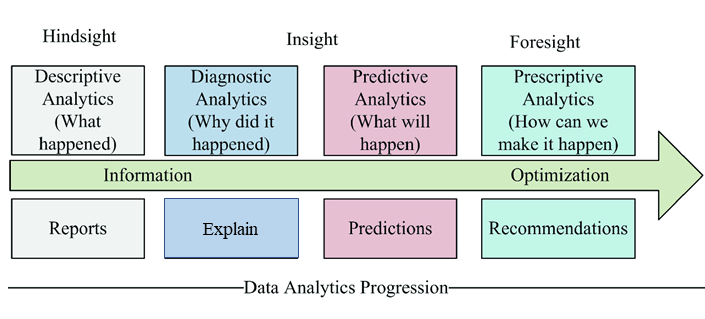Digital marketing analytics solves problems. Even if all things go well, there is still a problem – how to do better? It is a constant battle for decision-makers to compete either against some rivals or themselves. Therefore Davenport and his co-authors argued 15 years ago that high-performing enterprises built their competitive strategies around data-driven insights and the resulting decisions.
Four functions
Digital analytics provide the functions for marketers to see problems and make decisions upon them. Specifically, the functions are of four types which are to report, explain, predict, and recommend.
These four functions follow a data analytics progression from describing the problems to the final step of recommending optimal solutions. In their 2019 book chapter, Prachi S. Deshpande, Subhash C. Sharma, and Sateesh K. Peddoju illustrated the information-to-optimisation progression. The figure below is an adaptation of their discussions.

Digital analytics, according to the figure above, provides the sighting of the marketing problems in a sequence of hindsight, insight, and foresight. The ultimate purpose of the four functions is to optimise marketing value creation.
Corresponding to the four functions to report, explain, predict, and recommend are the well-known four types of digital analytics.
Descriptive analytics for reporting “what”
Descriptive analytics analyses data to tell what happened. It is generally the initial stage of data sighting. Since the data are about what already happened, the analysis creates hindsight.
The descriptive analytics mainly concentrated on “what” with the help of classification, clustering and segmentation of the data to discover patterns such as the central tendencies.
For such an example, Clicademy provides a data dashboard.
Diagnostic analytics for explaining “why”
The function of explanations using diagnostic analytics starts to create insights about why something happened. More complex analysis, often aided by computing power and algorithm, look for relationships between variables. This is the stage for the machine to learn about the patterns. However, the insights are still hindsight as of now.
Users of the diagnostic analytics need to be careful when taking the “why” as the causal explanation. It often requires controlled experiments to find out what caused what. More often, relationships between tested variables are correlations. Most A/B testings suggest correlations and associations between dependent and independent variables.
Predictive analytics for “so what”
Predictive analytics answers what is going to happen. Based on data patterns, analytics forecasts what will result from the predicted relationships between variables using regressions, simulations, and scenarios. This is the moment of “so what”.
Perhaps one of the most commonly predicted is how the current Covid-19 crisis will develop to affect every marketer in the world. Now the job is becoming more complex with the addition of a new deadly variable — the variants of the virus. It is the worst of the times for marketing, but one of the best times to see how predictive analytics works.
Prescriptive analytics for recommending “how”
Prescriptive analytics answers how to make the predictions to happen. This is the stage of decision-making. There should be a clear division of labour between algorithm and marketers. Computers are responsible for recommendations. Marketers make so-called data-driven decisions.
So this is the stage where marketers make the call. Analytics can point out the opportunities and even recommend how to take them. It is not that easy, though, to just follow the recommendations. It requires human judgement.
Conclusion
The digital analytics provides marketers with the functions to report, explain, and predict the problems and then recommend solutions. The time-reliant and increasingly automated sequences involve the four types of descriptive, diagnostic, predictive, and prescriptive analytics to inform marketers to make optimisation decisions.


